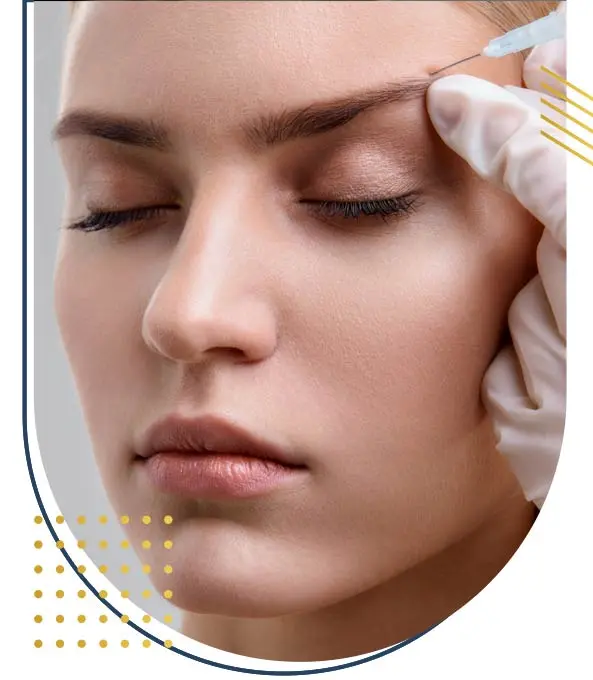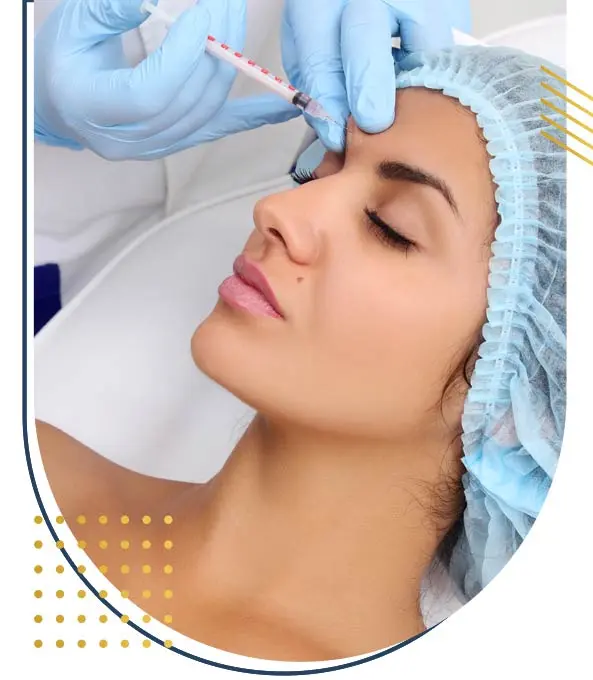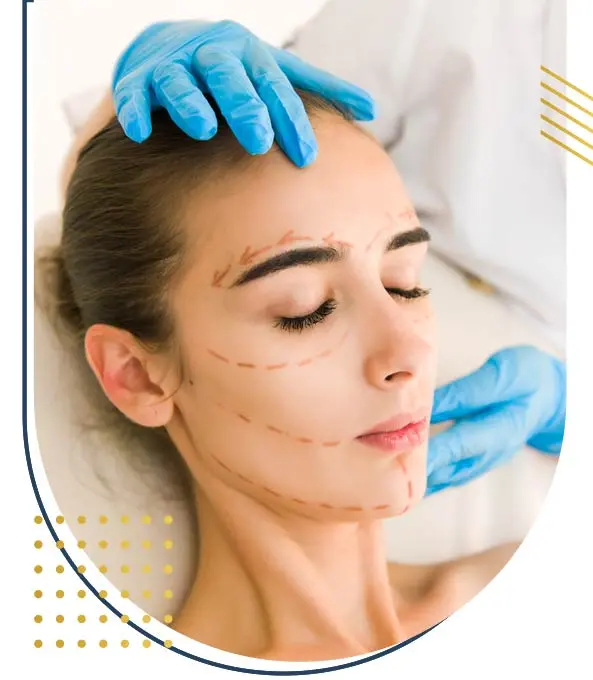
Blepharoplasty performed in Egypt is also known as eyelid surgery, it is an effective plastic intervention that consists of rejuvenating upper and lower eyelids for a more radiant look and this without changing its expression.
The objective of this procedure is to allow the patient to get rid of the tired appearance of the eyes by having a harmonious and rejuvenated look which will allow him to improve his self esteem.
Blepharoplasty price in Egypt
The price blepharoplasty Egypt is interesting and affordable, ask for your free online quote or contact us by phone on the phone numbers you will find on our website and we will give you blepharoplasty cost Egypt with all the information about this procedure.
What are the types of the Blepharoplasty procedure ?
Upper Blepharoplasty :
Upper blepharoplasty is a surgical procedure aimed at rejuvenating the appearance of the upper eyelids. It involves the removal of excess skin, muscle, and fat deposits from the upper eyelids to address drooping eyelids, puffiness, and hooding.
This procedure is commonly sought by individuals experiencing signs of aging such as sagging skin or impaired vision due to excess skin obstructing the natural fold of the eyelid. During the procedure, the surgeon makes incisions along the natural crease of the upper eyelid, allowing for discreet scarring post-surgery.
The excess tissue is then carefully excised, and the remaining skin is repositioned to create a more youthful and refreshed look.
Upper blepharoplasty can also enhance the contours of the upper eyelids, resulting in a more alert and rejuvenated appearance. Patients typically experience improved vision and a more youthful aesthetic following recovery, with minimal downtime required.

Lower Blepharoplasty :
Lower blepharoplasty is a cosmetic surgical procedure designed to address concerns related to the lower eyelids, such as puffiness, under-eye bags, and wrinkles.
This procedure targets excess skin, fat deposits, and muscle laxity in the lower eyelid area to create a smoother, more youthful appearance.
During the surgery, the surgeon may employ various techniques, including transconjunctival or transcutaneous approaches, depending on the individual's specific needs. Transconjunctival blepharoplasty involves making incisions inside the lower eyelid, which eliminates visible scarring and is particularly suitable for patients with isolated fat deposits.
On the other hand, transcutaneous blepharoplasty involves making incisions just below the lower lash line, allowing for direct access to address excess skin and muscle laxity.
Lower blepharoplasty can also incorporate additional procedures such as fat repositioning or laser resurfacing to further improve the overall appearance of the lower eyelids. Patients can expect to achieve a more refreshed and rejuvenated look following recovery, with long-lasting results that enhance facial harmony and symmetry.
Asian Blepharoplasty (Double Eyelid Surgery) :
Asian blepharoplasty, commonly known as double eyelid surgery, is a specialized procedure aimed at creating a defined upper eyelid crease in individuals of Asian descent who lack a natural supratarsal fold. This surgery is highly popular among individuals seeking to enhance the appearance of their eyes and achieve a more Westernized aesthetic.
During the procedure, the surgeon carefully creates a crease along the upper eyelid, typically positioned above the eyelash line, to mimic the natural appearance of an eyelid crease. The incision technique may vary depending on factors such as eyelid anatomy, desired crease height, and patient preferences.
Some techniques involve full-incision, partial-incision, or non-incision methods, each offering distinct advantages and outcomes. Asian blepharoplasty requires meticulous attention to detail to ensure symmetrical and natural-looking results that complement the patient's facial features. Following surgery, patients may experience temporary swelling and bruising, but these typically subside within a few weeks, revealing the desired eyelid contour.
Double eyelid surgery can significantly enhance the overall appearance of the eyes, providing patients with newfound confidence and satisfaction in their appearance.
Revision Blepharoplasty :
Revision blepharoplasty, also known as secondary eyelid surgery, is a corrective procedure performed to address unsatisfactory outcomes or complications resulting from previous blepharoplasty surgeries.
This specialized procedure is tailored to each patient's unique needs and may involve correcting asymmetry, addressing residual fat or tissue, or revising scar tissue to achieve optimal aesthetic and functional outcomes.
Revision blepharoplasty requires a thorough assessment of the patient's previous surgical history, including surgical techniques employed, anatomical changes, and any complications encountered.
The surgeon utilizes advanced techniques and meticulous surgical planning to achieve the desired improvements while minimizing the risk of further complications. Common reasons for undergoing revision blepharoplasty include inadequate eyelid contouring, asymmetry, eyelid malposition, or dissatisfaction with the aesthetic outcome of the initial procedure.
By addressing these concerns, revision blepharoplasty aims to restore balance and harmony to the eyelid region, providing patients with renewed confidence and satisfaction in their appearance.
Transconjunctival Blepharoplasty :
Transconjunctival blepharoplasty is a surgical technique primarily used for lower eyelid rejuvenation, particularly in patients with excess fat deposits and minimal skin laxity.
Unlike traditional blepharoplasty approaches that involve external incisions, transconjunctival blepharoplasty utilizes incisions made inside the lower eyelid, thereby avoiding visible scarring on the skin's surface.
This minimally invasive approach offers several advantages, including reduced risk of eyelid malposition, faster recovery times, and enhanced precision in targeting fat deposits. During the procedure, the surgeon creates small incisions along the inner lining of the lower eyelid, allowing access to the underlying fat pads.
The excess fat is then carefully sculpted or repositioned to improve lower eyelid contour and reduce puffiness. Transconjunctival blepharoplasty can be performed as a standalone procedure or combined with other techniques such as laser resurfacing or fat repositioning to achieve comprehensive rejuvenation of the lower eyelids. Patients typically experience minimal discomfort and swelling following surgery, with noticeable improvements in lower eyelid appearance and overall facial harmony.
Transcutaneous Blepharoplasty :
Transcutaneous blepharoplasty, also known as external blepharoplasty, is a surgical procedure used to rejuvenate the appearance of the upper or lower eyelids by removing excess skin, fat, and muscle tissue.
Unlike transconjunctival blepharoplasty, which involves internal incisions, transcutaneous blepharoplasty requires external incisions made along the natural creases of the eyelids. This approach provides the surgeon with direct access to the underlying structures, allowing for precise removal or repositioning of tissue to achieve the desired aesthetic outcome. Transcutaneous blepharoplasty is particularly beneficial for patients with significant skin laxity or excess tissue in the eyelid region.
During the procedure, the surgeon carefully excises excess skin and fat deposits before meticulously closing the incisions to minimize scarring. Transcutaneous blepharoplasty can address a range of concerns, including drooping upper eyelids, under-eye bags, and wrinkling, resulting in a more refreshed and youthful appearance.
Patients undergoing transcutaneous blepharoplasty may experience temporary swelling and bruising following surgery, but these effects typically resolve within a few weeks, revealing the final results of the procedure.
Laser Blepharoplasty :
Laser blepharoplasty is a minimally invasive surgical technique that utilizes laser technology to rejuvenate the appearance of the eyelids by targeting excess skin, fat, and muscle tissue.
This innovative approach offers several advantages over traditional surgical methods, including reduced bleeding, precision in tissue removal, and shorter recovery times.
During laser blepharoplasty, the surgeon uses a specialized laser device to make incisions and vaporize excess tissue, allowing for precise sculpting of the eyelid contours.
The laser also promotes skin tightening and collagen production, resulting in smoother, firmer skin around the eyes. Laser blepharoplasty can be customized to address specific concerns such as drooping upper eyelids, under-eye bags, or fine lines and wrinkles. The minimally invasive nature of this technique often leads to less postoperative discomfort and faster healing compared to traditional surgical approaches.
Additionally, the precision of the laser allows for enhanced control and accuracy, minimizing the risk of complications and optimizing aesthetic outcomes.
Patients undergoing laser blepharoplasty can expect to achieve natural-looking results with minimal scarring and downtime, ultimately rejuvenating their appearance and restoring confidence in their eye area.
Why undergoing blepharoplasty Egypt ?
Eyelid surgery Egypt is realized for many reasons :
- Having a tired and sad look
- Suffering from bags under the eyes
- Saggy upper eyelid skin which can lead to a decrease in the visual field
- Asymmetric eyelids
Before the intervention
Before your blepharoplasty, you must have a consultation with the surgeon in order to examine you, ask you many questions about your general health and give you some recommendations to follow before undergoing eyelid surgery.
Telling him about the medications you are taking is necessary, he must also know whether you are suffering from certain diseases or allergies… and all your previous surgeries, you will also be asked about dryness and watering of the eyes.
Among the recommendations given by the surgeon :
- You must stop smoking one month after the procedure and before
- You will have to avoid taking aspirin six weeks before the operation
- Blood analysis must be done before your blepharoplasty Egypt.
- You should stop eating and drinking at least 7 hours before the intervention.
Additional preparations.
Arrange for time off :
Plan to take time off from work or other commitments to allow for adequate rest and recovery following blepharoplasty.
The amount of time needed may vary depending on the extent of surgery and individual healing capacity. Your surgeon can provide guidance on how much time you should plan to take off.
Maintain a healthy diet :
Eating a well-balanced diet rich in vitamins, minerals, and protein can help support the healing process and promote optimal recovery after blepharoplasty.
Aim to consume plenty of fruits, vegetables, lean proteins, and whole grains in the weeks leading up to surgery.
Stay hydrated :
Proper hydration is essential for overall health and healing. Drink plenty of water in the days leading up to blepharoplasty to help maintain optimal hydration levels.
Avoid excessive alcohol and caffeine intake, as these can contribute to dehydration.
Avoid sun exposure :
Protect your skin from sun damage by avoiding prolonged sun exposure and wearing sunscreen with a high SPF rating, especially on the face and around the eyes.
Sunburn can increase the risk of complications and delay healing following blepharoplasty. Consider wearing a wide-brimmed hat and sunglasses when outdoors.
Prepare for anesthesia :
If your blepharoplasty will be performed under general anesthesia or sedation, your surgeon will provide specific instructions regarding fasting guidelines.
Typically, patients are required to abstain from eating or drinking for a certain period before surgery to reduce the risk of aspiration.
Arrange for childcare and pet care :
If you have young children or pets, arrange for childcare and pet care assistance during the initial stages of recovery.
You may be limited in your ability to lift heavy objects or engage in strenuous activities, so having help with childcare and pet care can alleviate stress and allow you to focus on healing.
Manage expectations :
Before undergoing blepharoplasty, have a realistic understanding of the potential outcomes and limitations of the procedure.
While blepharoplasty can improve the appearance of the eyelids and rejuvenate the eye area, it may not completely eliminate all signs of aging or achieve perfection. Discuss your goals and expectations with your surgeon to ensure they align with achievable outcomes.
Stay informed :
Educate yourself about the blepharoplasty procedure, including the surgical techniques involved, potential risks and complications, and expected recovery timeline.
Ask your surgeon any questions you may have and seek clarification on any aspects of the procedure that are unclear.
How is it performed ?
Blepharoplasty Egypt is realized under general anaesthesia.
- For the upper eyelids :
For an upper blepharoplasty, the incision is made in a natural fold in the hollow of the eyelid. As a result, the scar is very discreet. With this incision, the surgeon removes the excess skin and any fat pockets.
- For the lower eyelids :
- For a lower blepharoplasty, two techniques can be proposed :
Through the skin: the surgeon makes an incision under the eyelashes. It ends in a fold of the crow's feet in order to treat the sagging skin and muscles and to remove any fatty pockets.
The sutures are removed 5 days later.
Another technique : if it is only necessary to treat the problem of bags under the eyes without a significant skin slackening, the surgeon decides to use the conjunctival route : the inside of the eyelid so as to hide the incision on the internal mucous membrane of the eyelid. No scarring will therefore be visible.
Blepharoplasty Egypt :aftercare and recovery
After your blepharoplasty performed in Egypt, you may experience swelling, bruising and watery eyes that may occur within a relatively short period of time.
Ice packs can be used to relieve the swelling on the concerned areas.
Sometimes dry eyes and sensitivity to light may occur during the first few days.
- For the upper eyelids :
For 2 to 3 days, you may feel discomfort when closing your eyes or be more sensitive to light. Sun protection (sunglasses) is essential during the first three months.
- For the lower eyelids :
The side effects are minimal and really temporary: small haematoma...
In most cases, you can resume normal activities such as applying make-up, reading, playing sports, driving, resuming your professional activities within 2 weeks or 20 days depending on your case...
Following your surgeon’s advice and recommendations is essential for the smooth running of the intervention.
Blepharoplasty Egypt results
The results of your blepharoplasty realized in Egypt are spectacular.
You will be able to appreciate the first results after the intervention : the disappearance of the excess skin is perfectly visible.
But, the final results will be visible from the 3rd postoperative month.
The patient will thus obtain a fresh, radiant look, a smooth skin and a rejuvenated face which will allow him to regain self confidence by being comfortable with himself and with others as it also improves the quality of his life on social or personal level.
This operation can be performed with other interventions according to your case such as facelift.
What are the risks of the Blepharoplasty procedure ?
Bleeding :
Bleeding during or after surgery is a potential risk, although it is typically minimal and well-controlled. In some cases, excessive bleeding may require medical intervention.
Infection :
As with any surgical procedure, there is a risk of infection. Surgeons take precautions to minimize this risk, such as using sterile instruments and providing appropriate post-operative care. Patients may be prescribed antibiotics to further reduce the risk of infection.
Scarring :
While efforts are made to minimize scarring, there is always a possibility of visible scars following blepharoplasty. However, skilled surgeons use techniques to conceal incisions within the natural creases of the eyelids, resulting in less noticeable scarring over time.
Dry eyes :
Some patients may experience temporary or permanent dryness of the eyes following blepharoplasty. This can result from changes in tear production or eyelid positioning. Lubricating eye drops or ointments may be recommended to alleviate dryness.
Changes in eyelid position :
In rare cases, blepharoplasty may lead to changes in the position of the eyelids, such as eyelid drooping (ptosis) or eyelids pulling away from the eyeball (ectropion). These complications may require additional surgical correction.
Numbness or altered sensation :
Patients may experience temporary numbness or altered sensation in the eyelid area following surgery. This typically resolves as the tissues heal, but in some cases, it may persist.

Asymmetry :
Achieving perfect symmetry between the two eyelids can be challenging, and subtle differences in appearance may occur following blepharoplasty. While efforts are made to achieve balanced results, complete symmetry may not always be possible.
Vision changes :
In rare cases, blepharoplasty may cause temporary or permanent changes in vision, such as double vision or blurred vision. This risk is higher in procedures involving the upper eyelids and typically resolves as the tissues heal.
Anesthesia risks :
Blepharoplasty is usually performed under local anesthesia with sedation or general anesthesia. While these techniques are generally safe, there are inherent risks associated with anesthesia, such as allergic reactions or adverse effects on breathing and heart function.
Unsatisfactory results :
Despite careful planning and execution, some patients may be dissatisfied with the results of blepharoplasty. It's important for patients to have realistic expectations and communicate their goals clearly with their surgeon during the consultation process.

